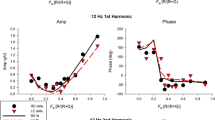Summary
Colour matches were made, with spectral and desaturated colours by a normal trichromat, a deuteranomalous, and a deuteranope. The matches were mutually judged. The results are:
-
1.
The deuteranope is a reduction type of the deuteranomalous.
-
2.
This result supports the hypothesis that deuteranomalous have only one anomalous photopigment, which is presumably located in the “green” cones.
-
3.
Findings and conclusion make the loss-hypothesis most likely, i.e. that the “green” photopigment is missing in the deuteranopic fovea.
Zusammenfassung
Mit spektralen und entsättigten Farben wurden Farbabgleiche von einem Farbennormalsichtigen, einem. Deuteranomalen und einem Deuteranopen durchgeführt und gegenseitig beurteilt. Die Ergebnisse sind folgende:
-
1.
Der Deuteranop ist ein Reduktionstyp des Deuteranomalen.
-
2.
Daraus folgt eine Bekräftigung der Hypothese, daß der Deuteranomale genau ein anomales Photopigment besitzt, das vermutlich in den “grünen” Zapfen zu lokalisieren ist.
-
3.
Befund und Schlußfolgerung machen die Ausfall-Hypothese am wahrscheinlichsten, d.h., daß in der deuteranopischen Fovea das „grüne“ Photopigment fehlt.
Similar content being viewed by others
Literatur
Alpern, M., Mindel, J., Torii, S.: Are there two types of deuteranopes? J. Physiol. (Lond.) 199, 443–456 (1968).
Alpern, M., Torii, S.: The luminosity curve of the deuteranomalous fovea. J. Gen. Physiol. 52, 738–749 (1968).
Deutsche Normen, DIN 5033, Farbmessung, Blatt 1 (1970), Blatt 2 (1984). Berlin: Beuth-Vertrieb.
Deutsche Normen, DIN 5031, Strahlungsphysik im optischen Bereich und Lichttechnik, Größen, Bezeichnungen, Einheiten, Blatt 6: Pupillen-Lichtstärke als Maß für die Netzhautbeleuchtung (1967). Berlin: Beuth-Vertrieb.
Graham, C. H.: Color: Data and theories. In: Graham, C. H. (editor), Vision and visual perception. New York: Wiley 1965.
Grützner, P., Kohlrausch, A.: Der Lichtverlust in der Macula lutea und das Farbensehen der Deuteranomalen. Pflügers Arch. ges. Physiol. 274, 318–330 (1961).
Koellner, H.: Zur Analyse der Ragleigh-Gleichung der anomalen Trichromaten. Arch. Augenheilk. 84, 177–194 (1919).
Koellner, H.: Die Abweichungen des Farbensinns. In: Handbuch der normalen und pathologischen Physiologie, herausgeg. v. A. Bethe, G. V. Bergmann, G. Embden, A. Ellinger. Bd. 12, 1. Hälfte, S. 502–535. Berlin: Springer 1929.
König, A., Dieterici, C.: Die Grundempfindungen in normalen und anomalen Farbensystemen und ihre Intensitätsverteilung im Spectrum. Z. Psychol. u. Physiol. Sinnesorg. 4, 241–347 (1892). Auch in: König, A., Gesammelte Abhandlungen zur Physiologischen Optik, S. 214–321. Leipzig: Barth 1903.
Kohlrausch, A.: Das Arbeiten mit dem Helmholtz-Königschen Spektralfarben-Mischapparat. Farbe 1, 11–23, 67–76 (1952).
Kries, J. v.: Über Farbensysteme. Z. Psychol. u. Physiol. Sinnesorg. 13, 241–324 (1897).
Kries, J. v.: Über die anomalen trichromatischen Farbensysteme. Z. Psychol. u. Physiol. Sinnesorg. 19, 63–69 (1899).
Kries, J. v.: Die Gesichtsempfindungen. In: Handbuch der Physiologie des Menschen, herausgeg. v. W. Nagel. Bd. 3, 1. Hälfte. Braunschweig: Vieweg 1904.
Kries, J. v.: Normale and anomale Farbensysteme. In: Handbuch der physiologischen Optik, v. H. v. Helmholtz, 3. Aufl, Bd. 2. Hamburg: Voss 1911.
Mitchell, D. E., Rushton, W. A. H.: Visual pigments in dichromats. Vision Res. 11, 1035–1043 (1971a).
Mitchell, D. E., Rushton, W. A. H.: The red/green pigments of normal vision. Vision Res. 11, 1045–1056 (1971b).
Nelson, J. H.: Anomalous trichromatism and its relation to normal trichromatism. Proc. physic. Soc. 15, 661–702 (1938).
Pickford, R. W.: Individual differences in colour vision, p. 47. London: Routledge and Kegan Paul 1951.
Pitt, F. H. G.: Characteristics of dichromatic vision, with an appendix on anomalous trichromatic vision. Spec. Rep. Ser. med. Res. Coun. (Lond.) No 200 (1935).
Pitt, F. H. G.: Some aspects of anomalous vision. Docum. ophthal. (Den Haag) 3, 307–317 (1949).
Reeb, O.: Grundlagen der Photometrie. Karlsruhe: Braun 1962.
Richards, W., Luria, S. M.: Recovery and spectral sensitivity curves for coloranomalous observers. Vision Res. 8, 929–938 (1968).
Richter, M.: Grundriß der Farbenlehre der Gegenwart. Dresden: Steinkopf 1940.
Rönne, H.: Ueber Uebergangsformen zwischen anomaler Trichromasie und dichromatischem Farbensystem. Mbl. Augenheilk. 80, 47–49 (1928).
Rushton, W. A. H.: A foveal pigment in the deuteranope. J. Physiol. (Lond.) 176, 24–37 (1965).
Rushton, W. A. H.: Review lecture: Pigments and signals in colour vision. J. Physiol. (Lond.) 220, 1–31 P (1972).
Scheibner, H.: Über die Begriffe Farbvalenz, Farbart und Chrominanz in der Farbmetrik. Farbe 18, 221–232 (1969).
Scheibner, H., Kellermann, F.-J., Boll, M.: Untersuchungen zur Protanopie und Protanomalie. Ber. dtsch. ophthal. Ges. 71 (1972) (im Druck).
Schmidt, F., Haensch: Neuer Helmholtz'scher Farbenmischapparat. Z. Instrumentent 13, 200–204 (1893).
Trendelenburg, W., Schmidt, J.: Untersuchungen über Vererbung von angeborener Farbenfehlsichtigkeit. S.-B. Preuß. Akad. Wiss., phys.-math. Kl. 1935 II. Berlin: Verlag der Akademie d. Wissenschaften in Kommission bei W. de Gruyter u. Co. 1935.
Vries, H. L. de: The fundamental response curves of normal and abnormal dichroatic eyes. Physica 14, 367–380 (1948).
Wald, G.: Defective color vision and its inheritance. Proc. nat. Acad. Sci. (Wash.) 55, 1347–1363 (1966a).
Wald, G.: Gibt es zwei verschiedene Typen von Deuteranopie? Ber. dtsch. ophthal. Ges. 67, 272–273 (1966b).
Watkins, B. D.: Foveal increment thresholds in normal and deutan observers. Vision Res. 9, 1185–1196 (1969).
Weigel, R. G.: Untersuchungen über die spektralrelative Hellempfindlichkeit des Auges. Diss. T. H. Karlsruhe 1930. Karlsruhe: Braun 1932.
Wright, W. D.: A re-determination of the trichromatic coefficients of the spectral colours. Trans. opt. Soc. 30, 141–164 (1928–1929).
Wright, W. D.: Researches on normal and defective colour vision. London: Kimpton 1946.
Wyszecki, G.: Valenzmetrische Untersuchung des Zusammenhangs zwischen normaler und anomaler Trichromasie. Farbe 2, 39–52 (1953).
Author information
Authors and Affiliations
Rights and permissions
About this article
Cite this article
Scheibner, H., Boll, M. Untersuchungen zur Deuteranopie und Deuteranomalie. Albrecht von Graefes Arch. Klin. Ophthalmol. 185, 145–160 (1972). https://doi.org/10.1007/BF00410058
Received:
Issue Date:
DOI: https://doi.org/10.1007/BF00410058




